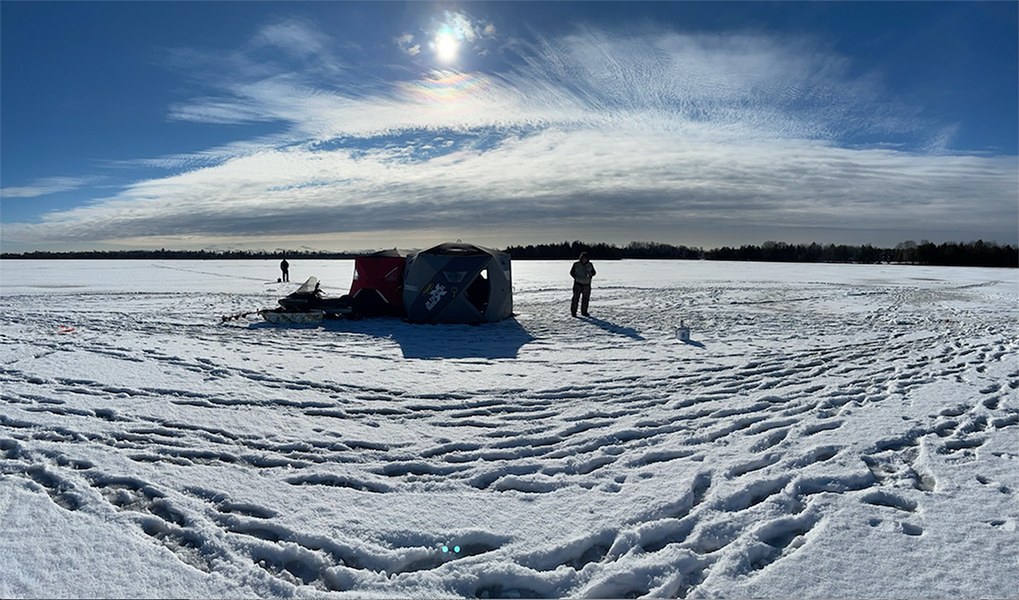Caroline Keson wakes up at 4:00 a.m. on a brisk winter day. She and her partner grab some caffeine, hop into their loaded truck, and head out in the dark morning to their ice fishing spot.
There’s a lot of commotion pre-sunrise as anglers unload their gear in preparation for hitting the frozen lake. “You pack everything onto your snowmobile or quad, get on all your warmest clothes and helmets, turn on the headlamps, and head out into oblivion,” said Keson.
Ice fishing is a great way to spend time outdoors in the winter and make family memories. So, for newcomers to ice fishing, here’s a guide to help you create the outdoor experience that’s right for you.
Licenses and a safety check
While beginners need not fear ice fishing, it requires some extra safety precautions. Patrick Kline of Cedar Swamp Sporting Goods in Petoskey keeps track of reported ice thickness and said that anglers will venture out on ice that’s around four inches thick. He recommends that people work within their own comfort zones. “We always tell people to check for yourself because could be six inches in one spot and two inches in another,” said Kline.
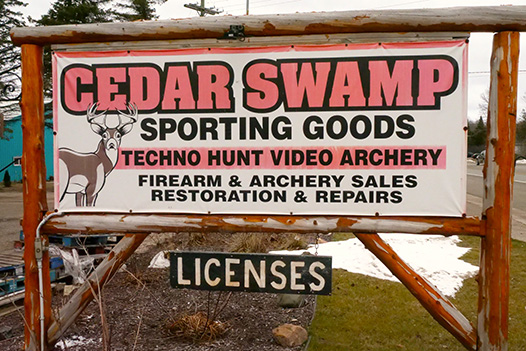
The road sign for Cedar Swamp Sporting Goods.
The Michigan Department of Natural Resources (DNR) echoes the need for caution. In their ice fishing guide, they stress the need to pay attention to the environment and test ice thickness with a tool called a spud. They also caution that dark, milky, or slushy ice can indicate weakness. For safety’s sake, it’s important to fish with companions, let an emergency contact know where you’re fishing, wear warm layers, and bring a cell phone. Definitely read the safety details on the DNR website.
What else will you need? A fishing license. The DNR fishing guide explains fees and requirements, seasons and possession limits for fish species, how to avoid aquatic invasive species, and more. Anglers can purchase a license at Michigan.gov/DNRLicenses or at a license agent. Sporting goods stores like Young’s Bait & Party Store in Alanson, along with Cedar Swamp and Dunham’s in Petoskey, and several other stores, sell licenses.
“You’d be surprised how many people buy a license this late in the year,” said Dave Stepanovich, owner of Young’s Bait and Party Store. “They don’t have boats so they can’t get out, and ice fishing can be fairly inexpensive, so that’s all they do.”
Depending on the lake habitat, you’ll be fishing for perch, walleye, rainbow or brown trout, burbot, or pike, among others.
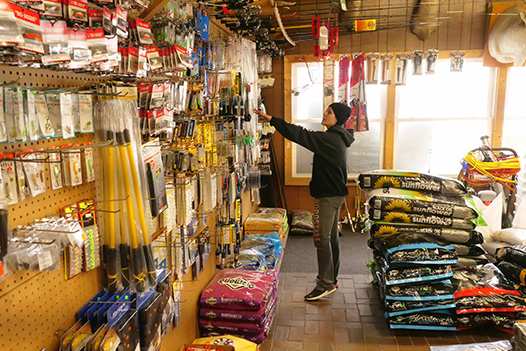
Barbie Balcom, a Young’s Bait & Party Store employee, shows off an impressive wall of ice fishing gear.
Gear up and get out
If you have any gear questions, make sure to consult with a local shop owner in the Petoskey area. They’ll help you find exactly what you’re looking for. Or, stay tuned for information on hiring a guide service who will provide the gear you need.
Warm clothes: You’ll need your warmest clothes for a day on the ice. Dress in layers that you can easily take on and off. Avoid cotton (especially for socks!), which can trap moisture and sap heat from your body. Wool and down layers, along with synthetics, are a better choice. Ice cleats, such as Yaktrax, slip over your boots and provide stability on slippery surfaces.
Transportation: As mentioned before, some anglers take snowmobiles or ATVs onto the ice. Barbie Balcom of Young’s Bait Shop likes to walk with gear on a sled, since more weight equals more pressure on the ice. Either way, you’ll need something to haul your supplies. Make sure to wear a helmet if you chose something with a motor.
Shelter: “Sometimes, it’s sometimes not the whole shelter that you need; you just have to get out of the wind,” said Stepanovich. He and Kline both recalled how anglers in the past would rig up big blue tarps to block out the wind. “Then we’d have a fire or a cookstove to keep warm,” said Kline.
Now, it’s common to see fabric or wooden structures to shelter ice fishers from brutal winds over a lake’s surface. An insulated pop-up shelter can range in price from less than $100 to a few thousand dollars. Local sporting goods stores can help you find an option that’s right for your crew. “Some people have their whole families out there with kids playing and a huge shelter for everyone,” said Stepanovich.
Keson uses a Mr. Heater Buddy in a fabric shanty to stay warm. A large shanty might even have room for a woodstove.
Don’t want to buy a shelter or haul one out onto the ice? Keep reading for tips on ice fishing rentals.
Fishing gear: There’s a variety of tackle out there, but you don’t have to break the bank to have a good time. As Kline mentioned, you can get everything you need for less than $100.
One option is a jigging rod, a small rod that anglers move very slightly to make the lure or bait bob up and down in the water. “It makes the lure look like a wounded minnow,” said Kline. If you’ve ever seen someone sitting with a fishing rod next to an ice hole, they’re probably jigging.
While Keson jigs inside the shelter, her partner runs tip-ups outside. Tip-ups are small mechanisms with flags that sit over a hole cut into the ice. The flags pop up and wave around when a fish takes the bait. They can be set to specific depths and are a good way to catch extra fish without holding onto a rod. Make sure to check the MI DNR fishing guide for limits on the allowed number of tip-ups and jigging lines.
Both jigging rods and tip-ups can cost less than $30 for basic models. However, a more expensive option is the JawJacker, a sensitive bait setter. The JawJacker is a small, flat tool with spikes that secure it next to the ice hole. It holds an angler’s rod in a bent position, and, when a fish starts to bite, the trigger sends the bent end of the rod skyward, hooking the fish.
You’ll also need live bait or lures for ice fishing. The local shops listed in this post have a variety of lures, minnows, worms, and more. Employees can help you find appropriate bait for your goals.
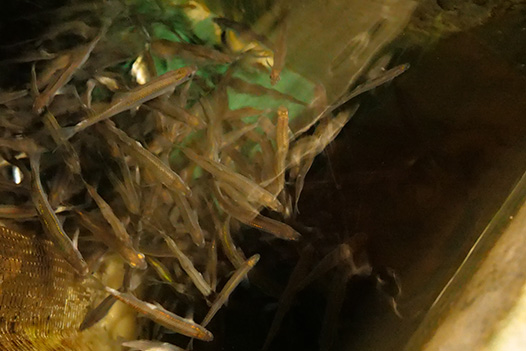
Bait minnows swimming in a tank. Minnows are available in a variety of sizes, depending on the kind of fish you’re targeting. Talk with an employee to determine the type of bait that will work for your needs.
One last note: you’ll need a seat to keep your behind off the ice. You can use something as simple as a five-gallon bucket—Kline displayed a seat cushion that fits atop one—or take some light chairs out with you.
Location: Northern Michigan is dotted with almost innumerable water bodies. Common ice fishing spots in our area include Pickerel-Crooked, Burt, Mullett, Paradise, Walloon, and Thumb Lakes, along with Lake Charlevoix.
“In general, a big lake with lots of different habitats and good water quality is a good bet,” said Keson, who has years of experience working on water quality issues. “Having enough oxygen in the water is important for those fish to survive with ice cover.” Ice fishing is just another good reason to protect our waters from common pollutants that cause plant overgrowth and deplete oxygen, such as excess fertilizers.
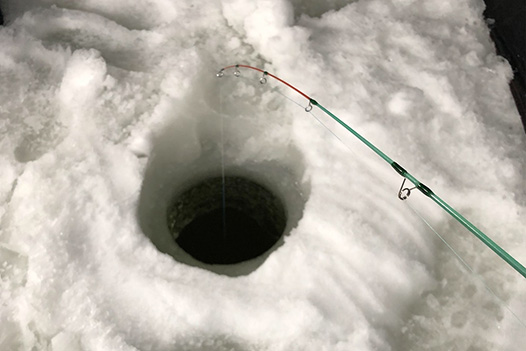
Caroline Keson holds a jigging pole, which is often shorter than a regular fishing pole, over an ice hole in a shanty.
Cutting the ice: These tools are a necessity. A spud is long metal pole with a blocky chisel that you spike into the ice to test thickness as you walk. An auger—a thick metal spiral with a pointed tip—is what you’ll use to cut fishing holes for jigging and tip-ups. Ice augers come in hand, gas, or battery-powered options. Keson suggested that anglers take care with their batteries since extreme cold can drain them.
Navigation: Navigation tools can vary depending on your circumstances. Since Keson drives far out onto the ice in the pre-dawn hours, she uses Navionics to help her find the best areas to fish. Someone who knows a lake quite well may be used to river outlets and areas to avoid. Others might fish fairly close to shore. A compass or GPS can be helpful if you’re planning a long trek.
Balcom found this out the hard way while ice fishing with her family on Burt Lake: “Right as we were about to leave, it started to snow and turned into a whiteout. We couldn’t see anything. We knew the shanty door faced the shore, so my husband took the lead and we just tried to walk in a straight line. The weather can change in a second; you have to be prepared out there.”
Outfitters and guides
What if you’re completely new to ice fishing? Maybe you don’t want to buy any gear before you try out the sport. Don’t worry, northern Michigan has options for you.
Cody Sems runs HardWater Adrenaline, an ice fishing guide service that covers just about everything you need for a day on the ice. “We focus on people who have never experienced it before,” said Sems, “so it’s a good opportunity to fish with someone who can show you how to do it safely.”
Sems offers six- or eleven-hour fishing packages. They include transportation out to an area Sems has successfully fished on Burt or Mullett Lake. He provides the safety instructions, ice shanty, fishing gear (including poles and tip-ups), seating, and a heater. The only things you have to bring are your Michigan fishing license and food and drinks for the day. Prices vary depending on the length of the excursion and number of people in the party; contact Sems for more information.
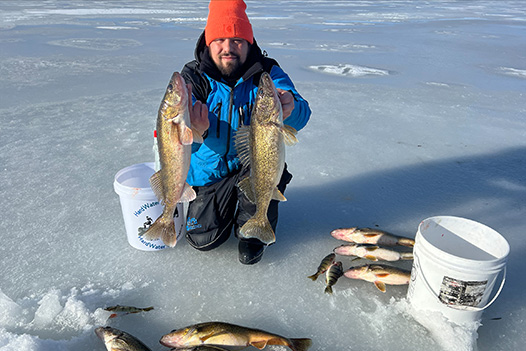
A customer shows off a day’s catch with outfitter HardWater Adrenaline.
“It’s a great service for visitors who don’t know the lakes and rivers,” said Sems. “There’s so much you can do, from ice skating to fishing, and I want to get people accustomed to the possibilities.”
At Offshore Igloos Ice Fishing Adventure, Doug Duke offers sleeper cabins on Burt Lake for people who usually own their own tackle. The variety of cabins can hold two to eight people and include solar power, LED lights, a cook stove and heater, bunk beds, a pre-drilled fishing hole, and a bucket potty. A few units even have ovens. Anglers can take their own snowmobiles to the cabins or have Duke transport them. He also rents snowmobiles and generators. Weekend reservations are a must and require a two-night stay, but the cabins are open on weekdays as well.
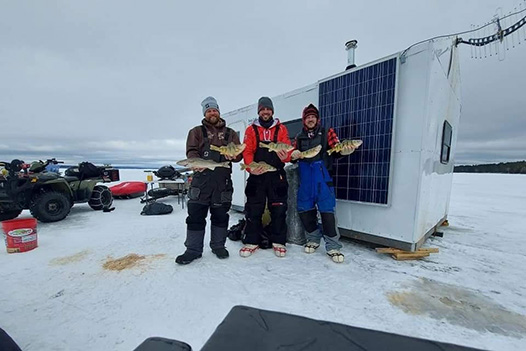
Offshore Igloos Ice Fishing Adventure includes sleeper cabins on Burt Lake with bunk beds and cooking gear. Make sure to bring sleeping bags, pillows, and warm clothes for a weekend or a week on the ice.
“We’ve had kids as young as two years old stay out in our cabins,” said Duke. “I once spent nine nights in a row on Burt Lake in one of them.”
Not looking to fully immerse yourself in the experience overnight? Petoskey area offers many lodging options.
Embrace the cold and have fun
This may seem like a long list of supplies and cautions. However, all you really need to do is stay safe and enjoy yourself. “You just need the basics,” said Keson. “You’ve got to have shelter from the wind, fishing equipment, and a way to get through the ice.”
Keson is so excited to ice fish she gears up months before the season starts. She recommended this ice fishing channel on YouTube for those of you who can’t wait for the season to start.
Disclaimer: This guide is meant to inform readers about an outdoor recreation opportunity. The information included here is for general guidance and is not meant to replace professional training or a guide service. Readers are responsible for their own safety and welfare should they practice any of the activities mentioned in this article. You should consult with a professional for advice before making any decisions regarding ice fishing. The products and stores mentioned in this article are included solely for informational purposes. The Petoskey Area Visitors Bureau does not endorse any particular venue or equipment.
Photos are courtesy of Jen DeMoss, Caroline Keson, Doug Duke, and Cody Sems
 About the Author: Jen DeMoss is a newcomer to the Petoskey area, and she loves all things northern Michigan. You can catch her paddling a canoe, hiking a trail, or swimming in Lake Michigan as often as the weather cooperates. She’d love to help you make the most of your time in this paradise she now calls home.
About the Author: Jen DeMoss is a newcomer to the Petoskey area, and she loves all things northern Michigan. You can catch her paddling a canoe, hiking a trail, or swimming in Lake Michigan as often as the weather cooperates. She’d love to help you make the most of your time in this paradise she now calls home.

